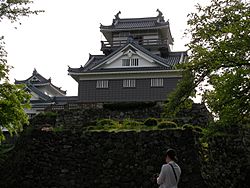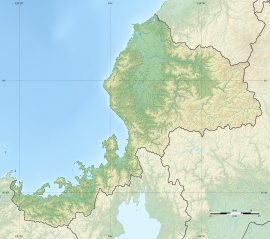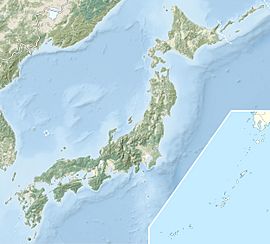Ōno Castle (Echizen Province) facts for kids
Quick facts for kids Ōno Castle |
|
|---|---|
| 大野城 | |
| Ōno, Fukui Prefecture, Japan | |

reconstructed donjon of Ōno Castle
|
|
| Coordinates | 35°59′11.64″N 136°28′59.15″E / 35.9865667°N 136.4830972°E |
| Type | Japanese castle |
| Site information | |
| Open to the public |
yes |
| Condition | partly reconstructed |
| Site history | |
| Built | 1580 |
| Built by | Kanamori Nagachika |
| In use | Sengoku-Edo period |
| Demolished | 1871 |
Ōno Castle (大野城, Ōno-jō) is a famous Japanese castle located in the city of Ōno, Fukui Prefecture, Japan. It sits in the Hokuriku region of the country.
This castle was built during the Sengoku period, a time of many wars in Japan. Later, during the Edo period, powerful lords called daimyō lived here. They ruled the Ōno Domain under the Tokugawa shogunate, which was the government of Japan at that time.
Contents
What Ōno Castle Looks Like
Ōno Castle is in the northeastern part of Echizen Province. It was built on a hill called Kameyama Hill. The castle stretches out for about 300 meters from east to west.
The most important part, the inner bailey, is at the very top of the hill. It has strong stone walls made from large, natural rocks. Other parts of the castle were built on lower levels. These areas were also protected by moats filled with water.
History of Ōno Castle
Building the Castle
In the early Sengoku period, the area around Ōno was controlled by the Asakura clan. However, Ōno was also a major base for a group called the Ikkō-ikki.
In 1575, a powerful leader named Oda Nobunaga defeated both the Asakura clan and the Ikkō-ikki. He then gave the Ōno area to his general, Kanamori Nagachika. Kanamori started building Ōno Castle using the newest designs of the time. The castle was finished by 1580.
Who Lived in the Castle?
Kanamori Nagachika later moved to another area in 1586. After him, other important figures like Aoki Kazunori and Oda Hidekatsu lived in the castle. They were sent by Toyotomi Hideyoshi, who was a very powerful ruler after Nobunaga.
After a big battle called the Battle of Sekigahara, Tokugawa Ieyasu became the most powerful person in Japan. In 1601, he gave the entire Echizen Province to his second son, Yūki Hideyasu. This area became known as Fukui Domain.
In 1624, Fukui Domain was divided. Yūki Hideyasu's third son, Matsudaira Naomasa, received a large area centered at Ōno. This became the Ōno Domain. Over the years, several different lords from the Matsudaira family ruled Ōno Castle.
The Doi Clan and Later Years
Later, the castle was given to a different family, the Doi clan. The Doi family ruled Ōno for eight generations.
In 1775, the castle unfortunately burned down. However, most of it was rebuilt by 1795, except for the main tower, called the donjon.
Ōno Domain often had money problems. But a lord named Doi Toshitada (who lived from 1811 to 1869) made many important changes. He brought in new ideas and Western technology. Even though Ōno was a small domain, it became known for its modern army and its special school during the Bakumatsu period.
After the Meiji restoration in 1868, the castle was taken down. Some of its gates were given to nearby Buddhist temples. The land where the castle stood was then used for government buildings.
Ōno Castle Today
Today, you can still see some parts of the original stone walls of Ōno Castle. There are also parts of the old castle town, called jōkamachi, with traditional samurai and merchant houses.
In 1968, a new main tower, or "faux-donjon," was built on the castle site. It looks like the original tower and is now a local history museum. In 2017, Ōno Castle was recognized as one of the Continued Top 100 Japanese Castles.
See also
 In Spanish: Castillo Echizen Ōno para niños
In Spanish: Castillo Echizen Ōno para niños
- Ōno Castle (Chikuzen Province)
- Ōno Castle (Chita District, Owari Province)





